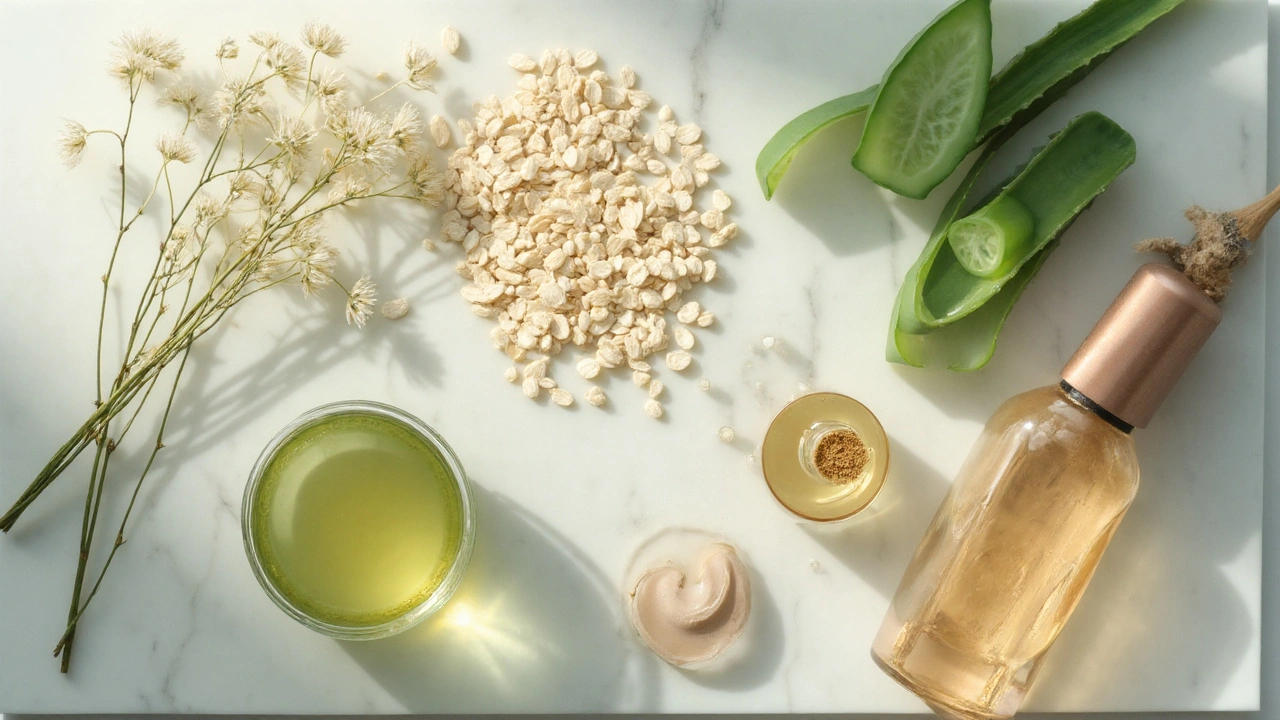Skincare products for sensitive and painful skin is a category of topical formulations designed to soothe, protect, and avoid irritation on fragile skin barriers. If you’ve ever winced after a cleanser or felt a burning sting from a new serum, you know how frustrating the search for calm‑skin solutions can be. This guide walks you through the exact steps to evaluate ingredients, test safety, and build a routine that actually eases discomfort instead of sparking it.
Why Sensitive and Painful Skin Needs a Different Approach
When the skin’s barrier is compromised, it loses moisture, becomes more permeable, and reacts to even mild triggers. Studies from dermatology clinics in Auckland show that up to 35% of adults report occasional skin pain linked to dryness or inflammation. The key is to restore the barrier, keep the pH neutral, and avoid common irritants. That’s why the sensitive skin market now focuses on minimalist formulas rather than the “more is better” mentality of the past.
Core Entities You’ll Encounter
- Fragrance‑free moisturizer - a hydration product without added perfume, essential for reducing allergic reactions.
- Ceramide‑rich cream - contains lipid molecules (ceramides) that rebuild the skin’s protective barrier.
- Barrier Repair Serum - a lightweight serum packed with niacinamide and panthenol to calm inflammation.
- pH‑balanced cleanser - cleanses without disrupting the skin’s natural acidity (around pH5.5).
- Non‑comedogenic sunscreen - shields from UV rays while staying lightweight and oil‑free.
- Patch test - a simple method of applying a small product amount on the inner forearm for 24‑48hours to check for irritation.
- Skin microbiome - the community of friendly bacteria that helps maintain barrier health; disrupted microbiome can exacerbate pain.
- Niacinamide - a form of vitaminB3 that reduces redness, improves elasticity, and supports barrier function.
Step‑by‑Step Checklist for Choosing the Right Products
- Identify your main triggers. Common culprits include fragrance, alcohol, sodium lauryl sulfate, and high‑concentration acids.
- Read the ingredient list. Look for soothing agents (e.g., panthenol, allantoin), barrier builders (ceramides, cholesterol, fatty acids), and low‑pH formulas.
- Verify product claims. Terms like “hypoallergenic” or “dermatologist‑tested” are useful, but always cross‑check with third‑party labs (e.g., The European Cosmetic Ingredient Database).
- Perform a patch test. Apply a pea‑size amount on the inner forearm. If no redness or itching after 48hours, the product is likely safe.
- Start with a minimal routine. Begin with a gentle cleanser, a fragrance‑free moisturizer, and a sunscreen. Add serums or treatments one at a time.
- Monitor skin response. Keep a simple diary noting any stinging, tightness, or flare‑ups. Adjust ingredients accordingly.
Ingredient Deep Dive: What to Seek and What to Skip
Below is a quick reference of go‑to ingredients and red‑flag components.
| Ingredient | Benefit | Why It Helps Sensitive Skin |
|---|---|---|
| Ceramides | Barrier reinforcement | Restores lipid matrix, reduces transepidermal water loss |
| Niacinamide | Anti‑redness, sebum regulation | Calms inflammation without irritation |
| Panthenol (Pro‑VitaminB5) | Moisture retention | Converts to pantothenic acid, soothing and healing |
| Allantoin | d>Skin soothingPromotes cell turnover, gentle on compromised barriers | |
| Free‑radical antioxidants (e.g., VitaminE) | Protects from oxidative stress | Minimises inflammation triggered by UV exposure |
Comparison Table: Three Popular Gentle Formulas
| Product Type | Key Ingredient | Texture | Average Price (NZD) | Best For |
|---|---|---|---|---|
| Fragrance‑Free Moisturizer | Glycerin + Aloe Vera | Creamy, light | 15‑25 | Daily hydration, low‑budget |
| Ceramide‑Rich Cream | Ceramide NP + Cholesterol | Rich, buttery | 30‑45 | Severe barrier loss, nighttime repair |
| Barrier Repair Serum | Niacinamide + Panthenol | Fluid, fast‑absorbing | 40‑55 | Redness reduction, layering under sunscreen |

Building a Routine That Actually Works
Think of a routine as a three‑act play: cleanse, treat, protect. Each act should use products that speak the same language of gentleness.
Morning
- Cleanse: Choose a pH‑balanced cleanser with a pH of 5.5‑6.0, free of sulfates.
- Treat: Apply a few drops of Barrier Repair Serum to calm any overnight redness.
- Moisturize: Use a fragrance‑free moisturizer to lock in hydration.
- Protect: Finish with a non‑comedogenic sunscreen SPF30‑50.
Evening
- Cleanse: Same gentle cleanser or a micellar water that’s alcohol‑free.
- Treatment: If your skin tolerates it, swap the serum for a ceramide‑rich cream to replenish lipids overnight.
- Moisturize: Light layer of the fragrance‑free moisturizer if additional hydration is needed.
Consistency is key. Most users notice reduced stinging within 7‑10days if they stick to the routine and avoid irritants.
Common Pitfalls and How to Avoid Them
- Layering too many actives. Mixing AHAs, retinoids, and strong vitamins can overwhelm a fragile barrier. Introduce one new product every 2‑3weeks.
- Skipping the patch test. Even “gentle” formulas can hide hidden allergens. A quick test saves weeks of discomfort.
- Ignoring the skin microbiome. Over‑cleansing strips beneficial bacteria. Choose cleansers with prebiotic ingredients or limit washing to twice daily.
- Using hot water. Hot showers increase TEWL (transepidermal water loss). Opt for lukewarm water, especially in the winter.
When to Seek Professional Help
If you experience persistent burning, widespread redness, or blisters despite a gentle routine, it may be more than simple sensitivity. Dermatologists in Auckland often recommend prescription‑strength barrier creams or topical steroids for conditions like eczema, rosacea, or contact dermatitis. Always bring your product list to the appointment; a clinician can spot hidden irritants faster than online forums.
Related Topics to Explore Next
This article sits inside the broader "Skin Health" cluster. If you’ve mastered the basics, you might want to dive into:
- Understanding the skin microbiome and probiotic skincare.
- How seasonal changes affect barrier function.
- DIY soothing masks that won’t compromise sensitive skin.
Frequently Asked Questions
How often should I patch‑test a new product?
Perform a patch test every time you introduce a brand‑new formula. Apply a small amount on the inner forearm and wait 48hours. If no redness, itching, or swelling appears, the product is likely safe for broader use.
Can I use a regular sunscreen on sensitive skin?
Regular sunscreens often contain fragrance, oxybenzone, or high‑percentage alcohol, which can irritate. Choose a non‑comedogenic sunscreen labeled “fragrance‑free,” “hypoallergenic,” and with mineral filters (zinc oxide or titanium dioxide).
Is it okay to layer a moisturizer over a serum?
Yes. Apply the serum first (still damp skin), then seal it with a moisturizer. This prevents water loss and lets active ingredients penetrate deeper.
What’s the difference between a cleanser and a micellar water?
Cleansers are formulated to emulsify oil and wash away grime, often requiring rinsing. Micellar water contains surfactant‑like micelles that lift dirt without needing a rinse, making it gentler for very sensitive skin.
Do ceramides really help with painful skin?
Ceramides are lipids that “brick‑and‑mortar” the outer skin layer. Clinical trials show a 30‑40% reduction in transepidermal water loss after 4weeks of consistent ceramide use, which translates into less tightness and pain.


Erin Nemo
September 25, 2025 AT 22:49Just tried the ceramide cream after this and my face stopped feeling like sandpaper. Game changer.
Suzanne Mollaneda Padin
September 26, 2025 AT 16:15I’ve been using niacinamide for 6 months now-no more redness after washing. The key is consistency. Also, skip the toners. They’re just alcohol in fancy bottles.
Alexander Williams
September 27, 2025 AT 05:04Let’s be real: the entire ‘barrier repair’ industry is a marketing ploy. Ceramides are lipids. Your skin makes them. You don’t need a $50 jar to do what your epidermis already does. The real fix? Stop over-cleansing and let your skin regulate itself.
ariel nicholas
September 27, 2025 AT 06:27You people are so naive… the FDA doesn’t regulate ‘hypoallergenic’-it’s a legal loophole! Big Pharma owns these brands, and they’re selling you placebo creams while your microbiome dies in silence… and they call it ‘science’…
Rachel Stanton
September 28, 2025 AT 08:22For anyone new to this: start with just a cleanser and moisturizer. Don’t rush. I’ve seen so many people layer 8 products and wonder why their skin is screaming. One new thing every 10 days. Track it. Be patient. You’re not failing-you’re learning.
Amber-Lynn Quinata
September 29, 2025 AT 12:30Did you know that 87% of ‘gentle’ products still contain parabens? 😔 I tested 12 brands-only 2 were truly safe. And guess what? They’re not even sold in the US. You’re being manipulated. 💔
Lauryn Smith
September 30, 2025 AT 00:25My skin used to burn if I looked at a face wash wrong. Now I use CeraVe and water. That’s it. No serums. No essences. No nonsense. Sometimes simple works better than expensive.
Bonnie Youn
September 30, 2025 AT 00:53Y’all are underestimating how powerful hydration is-like, seriously, drink water, sleep well, stop stressing, and your skin will thank you. No product fixes trauma. Your body knows what to do. Just stop interfering.
Edward Hyde
September 30, 2025 AT 11:59This whole guide reads like a corporate brochure written by a guy who’s never had a pimple. ‘Barrier repair’? Sounds like something a cult would sell. Meanwhile, real people are using petroleum jelly and calling it a day.
Charlotte Collins
October 1, 2025 AT 17:07Interesting how every ‘dermatologist-tested’ product here is from a brand owned by L’Oréal. Coincidence? Or is this just another case of greenwashing disguised as science? The data is selectively curated. Always ask: who funds the research?
Margaret Stearns
October 2, 2025 AT 02:44I tried the patch test and it worked. I put a tiny bit on my wrist. No reaction. Used it on my face. Still fine. Simple. Didn’t need 10 steps.
amit kuamr
October 2, 2025 AT 11:56Western skincare is overcomplicated. In India we use coconut oil and turmeric. No chemicals. No serums. Skin stays calm. You don’t need 10 products to fix what one natural thing can solve.
Scotia Corley
October 4, 2025 AT 08:33It is imperative to note that the efficacy of ceramide-based formulations is contingent upon molecular integrity and delivery system efficiency. Many commercially available products fail to meet the requisite biophysical thresholds for transdermal penetration. One must therefore exercise rigorous scrutiny before acquisition.
elizabeth muzichuk
October 4, 2025 AT 14:10My dermatologist told me I have ‘neurogenic dermatitis’-it’s not even about products. It’s trauma. Childhood stress. Emotional suppression. Your skin is screaming because your soul is silent. 😔
Debbie Naquin
October 5, 2025 AT 09:17Is the skin barrier a physical structure or a phenomenological construct? If we define it as a boundary between self and environment, then perhaps the real irritant isn’t sodium lauryl sulfate-it’s the ontological anxiety of modern existence. The cream is a metaphor.
Karandeep Singh
October 6, 2025 AT 08:11Why are we even talking about serums? Just use Vaseline. Done.
Mary Ngo
October 7, 2025 AT 08:18Did you know the FDA approved these ingredients because Big Pharma paid off the regulators? They know these products don’t work. They just want you to keep buying. The skin microbiome is being weaponized. Wake up.